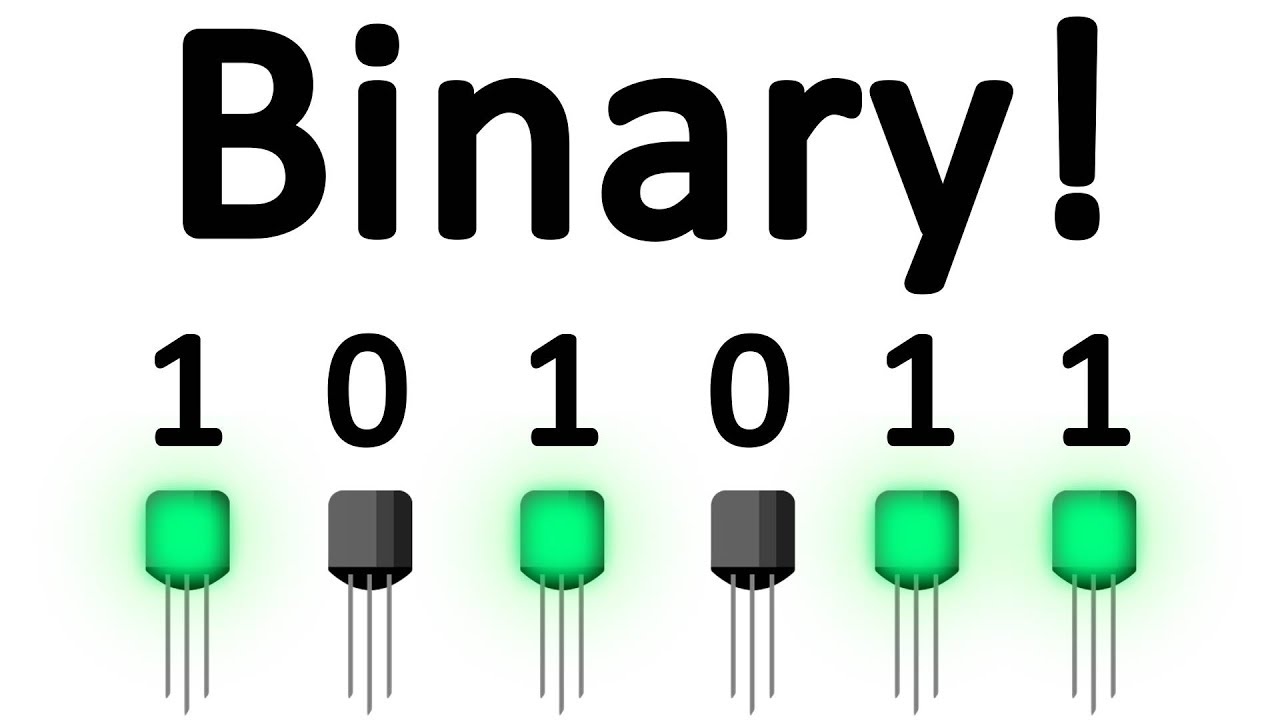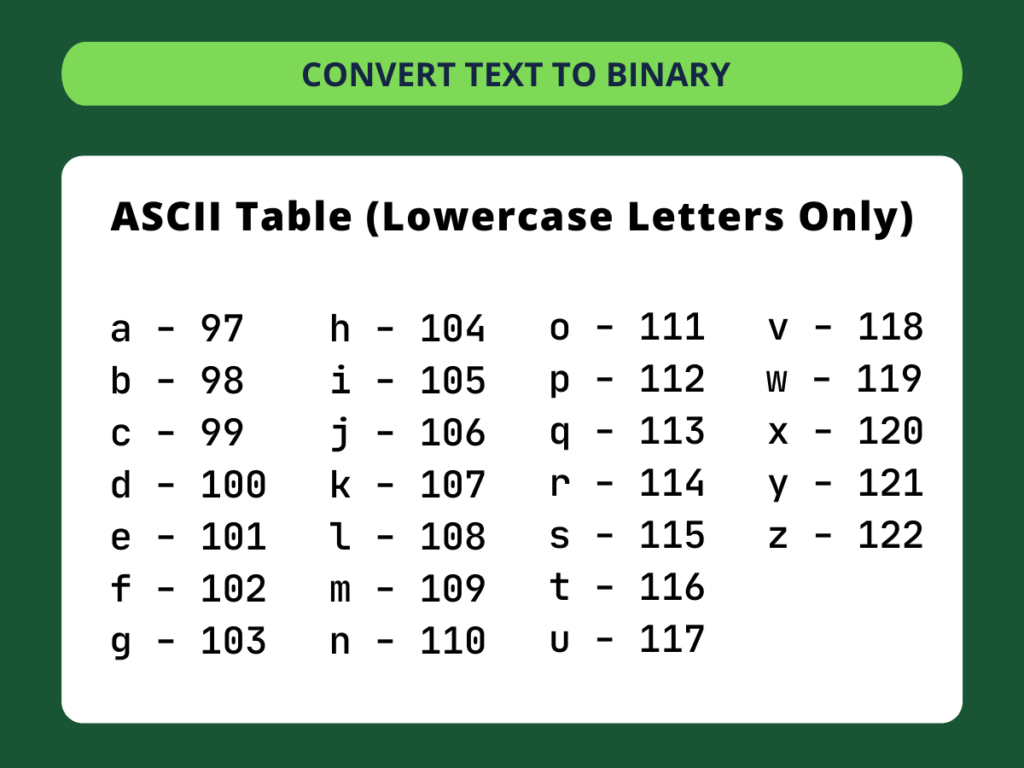Text To Binary
The Text to Binary Converter tool allows you to convert text into binary code, providing an accurate and instant translation of your input. This tool is perfect for students, developers, and anyone interested in understanding or utilizing binary code for various applications. The process is straightforward and efficient, ensuring precise binary conversions every time.
Share on Social Media:
Effortless Text to Binary Conversion: Simplify Your Encoding!
Converting text to binary is a fundamental skill in the digital world. This article demystifies the process, from understanding binary code basics to using online conversion tools. Get ready to translate text into binary, step by step, and learn its importance in technology.
Key Takeaways
Binary code, consisting of ‘0s’ and ‘1s’, is the fundamental language that enables computers to understand and execute commands, playing an essential role from simple computations to complex program executions.
Manual conversion of text to binary is facilitated by ASCII values that represent each character’s unique binary number, allowing for a systematic conversion of text characters into their respective 7 or 8-bit binary codes.
Online text to binary converters provide a user-friendly and efficient solution for converting text to binary, eliminating the need for manual conversion and catering to contemporary demands for speed, reliability, and accessibility.
Understanding the Basics of Binary Code

At the heart of every beep, every pixel, and every digital action lies binary code—the fundamental alphabet of modern technology. Envision a language so ubiquitous yet invisible, a binary system that shapes our experiences across countless digital landscapes. It’s the binary code that breathes life into machines, turning abstract concepts into tangible outputs.
But what exactly is this binary code, and how does it function within the intricate circuits of our computers?
What is Binary Code?
Binary code is the distilled essence of computing, a binary numeral system where bits—binary digits—stand as the smallest unit of data. Picture these bits as tiny on-off switches, where a flip to ‘0’ or ‘1’ can signify vast realms of meaning. From the simplest command to the most complex program, binary code is the lexicon that translates our digital desires into a form that computers can comprehend and act upon.
It’s a binary language, consisting of only two digits, yet it holds the power to create the vast array of colors on your screen or the notes in your favorite song.
The Role of Binary in Computers
Dive deeper into the digital domain, and you’ll find binary code at the core of every computation, every piece of stored knowledge, and every executed command. It’s the binary number system that allows the central processing units (CPUs) at the heart of our computers to perform feats of logic and arithmetic that seem like magic. Binary translation is not just a process; it’s the transformation of human intent into a binary string of ‘0s and ‘1s’ that can be interpreted and acted upon by machines. By using the binary system internally, our computers can efficiently process and execute these commands.
From the simple act of typing a letter to launching a spacecraft, binary code is the silent conductor orchestrating every move.
Converting Text to Binary: A Step-by-Step Guide

Transitioning from theory to practice, let’s embark on a journey of converting text to binary. Whether you’re a budding programmer or a curious mind, the ability to convert binary code is an invaluable skill in the digital age. But how does one transform the written word into a binary byte? The answer lies in a systematic approach using ASCII values and manual conversion.
Follow along as we decode the process of converting text, character by character, into the binary language of computers.
Using ASCII Values for Conversion
The ASCII table—a map of the digital terrain—serves as the guidepost for this transformation, assigning unique binary numbers to every character and symbol we use. Through character encoding, each letter, number, and punctuation mark is represented by a 7 or 8-bit binary code, allowing for a direct translation from text characters to binary digits and their corresponding decimal value.
By referencing the ASCII value for each character, we pave the way for a seamless conversion, ensuring that the integrity of the original text is preserved in its binary form.
Manual Conversion Process
With the ASCII values in hand, the manual conversion process unfolds like a puzzle, each piece fitting into its place to reveal the complete binary picture. The methodical translation of decimal values to binary numbers might seem daunting, but it’s a logical progression that, once mastered, can be performed with ease.
As each character’s binary equivalent is concatenated to form a string, you’ll witness the metamorphosis of plain English text into its fundamental binary essence.
Text to Binary Converter Tools Explained

In our quest for efficiency, technology bestows upon us tools that streamline complicated tasks into simple clicks. Online to binary translator tools, such as binary convert text to binary code converter tools, epitomize this principle, offering a bridge between the realms of human language and binary code. With these binary converter tools at your disposal, you no longer need to labor through manual conversion.
Let’s explore how these digital alchemists can turn your text into binary with astonishing speed and precision.
How to Use an Online Text to Binary Converter
Imagine a tool as intuitive as your favorite app, where converting text to binary is as simple as entering your text and clicking a button. Online text to binary converters, like Text To Binary by PagesTools.com, offer just that—a user-friendly interface that transforms your words into binary code in the blink of an eye.
With no need for elaborate procedures, these converters empower you to perform translations effortlessly, allowing you to focus on creativity rather than conversion.
Key Features of Online Converters
The allure of online text to binary converters doesn’t end with their ease of use. These tools are designed for speed and reliability, ensuring that the binary conversion of your text is both swift and accurate. Whether you’re using a desktop or mobile phone, the ability to enter text or upload a file caters to the modern need for accessibility and convenience.
With a few keystrokes and a click, your text is converted, ready to be copied, saved, or used in whatever binary journey lies ahead.
Practical Applications of Binary Translation

Peering beyond the process of conversion, we find binary translation engrained in the very fabric of our digital lives. Its practical applications are as diverse as they are vital, from ensuring interoperability between different systems to securing the data that courses through the veins of our networks.
Binary code is not merely a theoretical concept; it’s a practical tool that shapes our interaction with technology in myriad ways. A binary code translator can help us better understand and utilize this essential aspect of computing.
Encoding Data for Digital Systems
The act of encoding data in binary format is akin to translating a novel into a new language—it allows the original content to be understood in a different context, preserving its essence while adapting it for a new audience. In the digital realm, this means ensuring that data is compatible and secure across multiple systems and platforms.
The binary string becomes a universal passport, granting information the ability to traverse and be processed by a constellation of digital electronic circuits.
Communication Between Devices
Binary code is the lingua franca that enables devices to converse across the digital divide, ensuring that the message sent is the message received, whether it’s an email, a command to a smart appliance, or a streamed video. As these binary pulses travel through networks, they carry with them the essence of our communications, meticulously encoded to safeguard against corruption and misinterpretation, facilitating a seamless exchange of ideas and information.
Advanced Binary Concepts Demystified

As we delve into the realm of advanced binary concepts, we encounter the nuanced understanding of data representation that underpins much of modern computing. Grasping these concepts is like peering into the matrix of the digital world—revealing the intricate relationships between binary and other numeral systems, and the importance of precision in data measurement.
Bits vs. Bytes: Understanding the Difference
The distinction between bits and bytes is fundamental to computing, yet often misunderstood. Envision bits as the atoms of the digital world—indivisible units of data—while bytes are akin to molecules, composed of eight bits and capable of conveying more complex information.
Bytes serve as the canvas on which the binary code paints its data portraits, from the characters on a page to the pixels in an image, each byte a brushstroke contributing to the digital masterpiece.
From Binary to Hexadecimal and Beyond
Venturing further into the binary landscape, we encounter the hexadecimal system—a base-16 shorthand that simplifies the representation of binary data. This system allows for a more compact and human-readable format, easing the interpretation and manipulation of binary code. Understanding hexadecimal is not just about learning a new number system; it’s about unlocking a more efficient way to traverse the binary world.
Summary
As our journey through the binary landscape concludes, we reflect on the profound simplicity and versatility of binary code. From the basics of binary digits to the complexities of data encryption and advanced numeral systems, we’ve unraveled the threads that weave together the digital tapestry of our world. Whether through manual conversion or the use of sophisticated tools, the power to translate and utilize binary code is within your grasp, ready to empower your ventures in the digital realm.
Frequently Asked Questions
What is the simplest way to convert text to binary?
The simplest way is to use an online text to binary converter, where you can input the text and click to convert it into binary.
Can I convert text to binary without knowing ASCII values?
Yes, you can easily convert text to binary without knowing ASCII values by using online conversion tools.
Why is binary code important in computing?
Binary code is crucial in computing as it forms the basis of digital technology and allows computers to store, process, and communicate data effectively.
What is the difference between a bit and a byte?
The main difference between a bit and a byte is that a bit is a single binary digit, either 0 or 1, while a byte consists of 8 bits and is the standard unit of data used in computing.
How does binary code facilitate communication between devices?
Binary code facilitates communication between devices by encoding information into a universal digital format that can be transmitted across networks, ensuring accurate interpretation and display of the data by different devices.